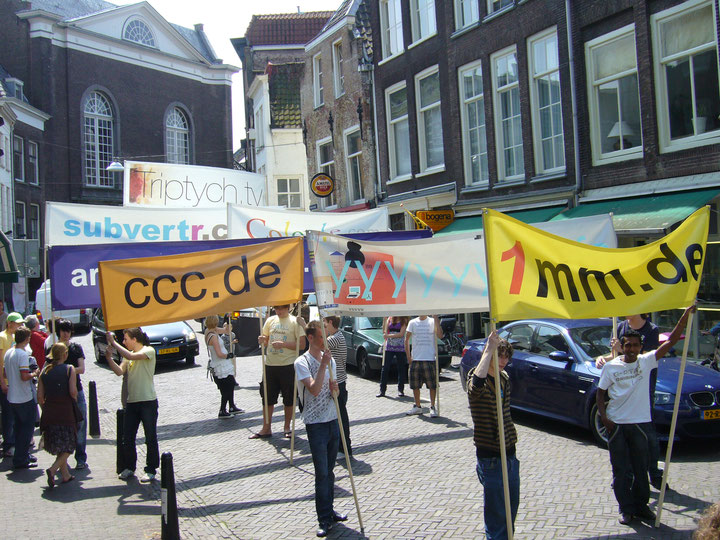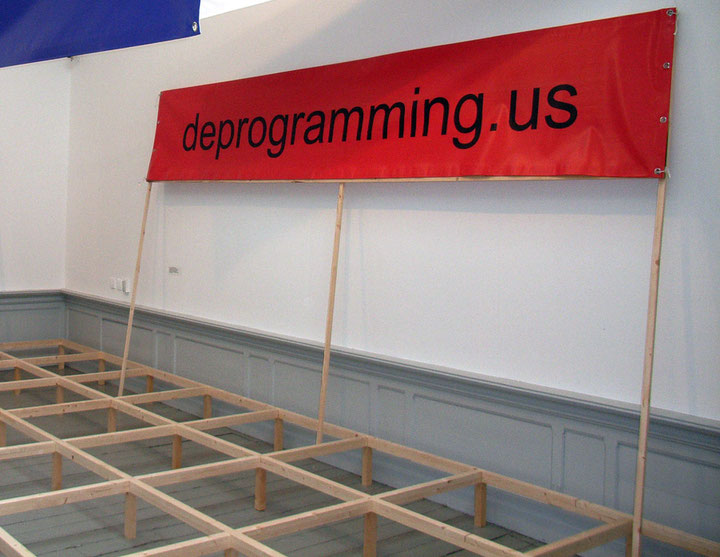Issue 4/2008 - Net section
A Matter of Translation: »Webcra.sh/2800«
On the Transfer of Net Art to Real Space
»Just as a tangent touches a circle lightly and at but one point, with this touch rather than with the point setting the law according to which it is to continue on its straight path to infinity, a translation touches the original lightly and only at the infinitely small point of the sense, thereupon pursuing its own course according to the laws of fidelity in the freedom of linguistic flux.«1
No computers, no monitors, no digital prints and above all no Internet: »Webcra.sh/2800«2 is both the title and the Internet address of an exhibition shown in May 2008 at the Urban Explorers Festival in Dordrecht (Netherlands), which was mostly limited to the Link as representative feature of Net Art work in real space.
The show was curated by Joan Heemskerk and Dirk Paesmans, better known by the pseudonym Jodi,3 the name under which the Dutch-Belgian artist duo has been doing media art since the mid-1990s under the label »net.art.«4 »The selection of Net Art works was based on the strict connection of title, URL and content of the websites shown,« as Jodi explained. The title of the exhibition does its part in explaining this endeavor: the top-level domain ».sh«5 repeats the name of the host in the first part of the URL. The hybrid word »webcra.sh« that results is supplemented with the sub-directory »/2800.« By mixing up the digits of the year 2008, hardly noticeable at first glance, the curators on the one hand reinforce the exhibition concept, which is rooted in the mutation of URLs and the corresponding websites. On the other hand, they also allude to those features with which users are confronted when visiting Net Art pages: the disassembling and recombining of the structures of the Internet and the toying with its specific multimediality, the creation of self-referential and ephemeral text, image and sound worlds as well as a semiotic flicker that continually regenerates itself.
The exhibition encompasses works by Italian artist Salvatore Iaconesi6 as well as the project »Deprogramming.us,«7 whose organizers speak out by means of code on behalf of creative hacking procedures. The so-called »Single Serving Sites« by Dutch artist Rafael Rozendaal8 deal with text-image relations in websites that consist only of a single sub-page and which produce a reduced pictorial language. Also to be found among the selected works are however web pages by groups such as the Chaos Computer Club9 from Hamburg and conceptual projects by the Italian media collective Les Liens Invisibles.10
What is special about the presentation of »Webcra.sh/2800« in real space is the reduction to a single presentation format: the display is made up of portable banners on which the URLs of the various artworks are printed. The link is thus understood here as a fundamental method for connecting two or more sets of Internet content with one another and consequently creating a network of references, associations and cross-listings. Jodi use the link to represent the artwork in real space, but at the same time maintain a conceptual connection to the Internet – despite object-like displays. With this deft curatorial twist, the artworks therefore stay where they can be called up at any time, and yet are still given a re-presentation form in real space, which then pulls the visitors back into the Net and hence into their role as users. Heemskerk and Paesmans assume that a Net Art work cannot exist without a link, explaining in an e-mail conversation: »A link is the address of the website without which the artwork will not appear on the screen. It is the on-button and at the same time part of the actual work. As the first line of code, the link activates a program that excludes all other pages and brings us from real space into the Net.«
Unlike curators of conventional art, the curator of Internet-based art acts on the same media level as the artists. The curatorial process, consisting of reception, selection, interpretation and mediation, thus likewise needs to be transferred with all its characteristics into real space. Asked whether Net Art can really be exhibited at all, Jodi answer: »Yes, but ›exhibition‹ is not the right word for it. Just as it is not possible to ›exhibit‹ a film, it is not possible to ›show‹ a website. This has to do with the fact that there is no defined time period for the use of websites. As curator, one has to find a way to bring the recipients onto the web page in question and not onto just any random screen.«
On the formal level the banners on view quote the background color of the pages on the Web. In addition to designing the yellow-orange, red and blue banners, whose typography also matches the artworks in some cases, the exhibition also involved a demonstration that took place in Dordrecht with people carrying these banners. The performative and temporal occupation of the public space with Web addresses can be read as an allusion to the omnipresence of links in our everyday lives. Following the demonstration the banners were brought into the exhibition space and installed there as network nodes. In order to imitate the interaction with Net Art works, visitors to the exhibition had to themselves go into action and could only cross the room by immersing themselves in this agglomeration of references via a wooden grid laid out on the floor. »In order to guide visitors to the show into the Net, one can write keywords on the wall or other surfaces, or simply the Web address. If you are separated from the works, it animates you to look up the URLs later – ›when and where you like, which is the Internet‹.« The artist duo’s answer to the question of whether their work in the Urban Explorers Festival was more of an artistic or curatorial nature was: »Both. We installed a program in real space.«
The exhibition »Webcra.sh/2800« deals mainly with activities on the Internet, which Jodi have been exploring as artists since the mid-1990s. But despite, or perhaps precisely because of its restrictive formal focus on art in the tradition of »net.art,« it is a successful example of the translation of these artworks into real space. The choice of a display form that takes its point of departure from the Internet allows for an adequate representation on both levels, i.e. online as well as offline, together with a reinterpretation of the individual works in a context as yet unknown at the time of the show. The change in perspective to which visitors can submit in the course of this multimedia transfer resembles the way in which »the tangent touches the circle lightly and at but one point,« i.e. it is like a free translation of the original, which according to context is reformulated and must now be dispatched into the »language’s liberty of movement.«
Translated by Jennifer Taylor-Gaida
1 Walter Benjamin, The Task of the Translator: An Introduction to the Translation of Baudelaire\'s Tableaux Parisiens, in: Lawrence Venuti (ed.), \"The Translation Studies Reader\", Second Edition, New York: Routledge, 2004, p.75-83
2 http://webcra.sh/2800
3 http://jodi.org
4 Rachel Greene, Internet Art. London 2005, p. 55.
5 The country code for the island nation of Saint Helena.
6 http://www.artisopensource.net
7 http://deprogramming.us
8 http://www.iamveryverysorry.com
9 http://ccc.de
10 http://www.lesliensinvisibles.org

